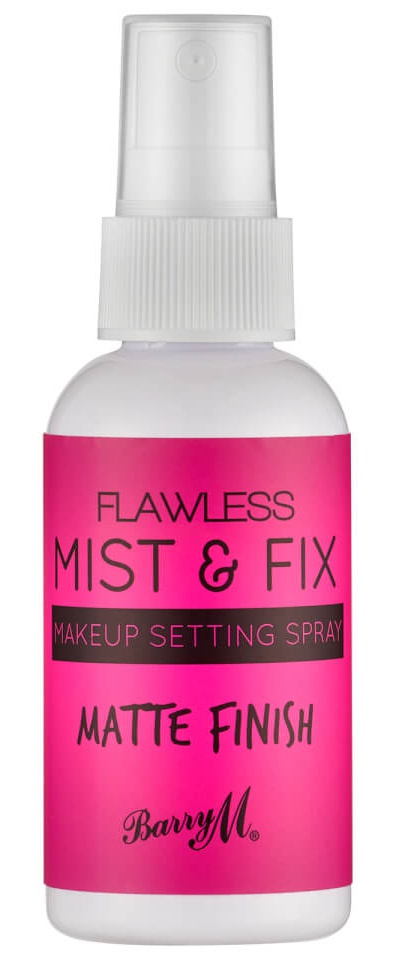
Makeup Setting Spray Matte Finish
Highlights
Key Ingredients
Skim through
| Ingredient name | what-it-does | irr., com. | ID-Rating |
|---|---|---|---|
| Aqua | solvent | ||
| Propylene Glycol | moisturizer/humectant, solvent | 0, 0 | |
| VP/VA Copolymer | |||
| Alcohol | antimicrobial/antibacterial, solvent, viscosity controlling | icky | |
| Phenoxyethanol | preservative | ||
| Disodium EDTA | chelating | ||
| Centaurea Cyanus Flower Extract | |||
| Sodium Salicylate | preservative | ||
| Plantago Lanceolata Leaf Extract | soothing, antioxidant, antimicrobial/antibacterial | goodie | |
| Mahonia Aquifolium Extract |
Barry M Makeup Setting Spray Matte FinishIngredients explained
Good old water, aka H2O. The most common skincare ingredient of all. You can usually find it right in the very first spot of the ingredient list, meaning it’s the biggest thing out of all the stuff that makes up the product.
It’s mainly a solvent for ingredients that do not like to dissolve in oils but rather in water.
Once inside the skin, it hydrates, but not from the outside - putting pure water on the skin (hello long baths!) is drying.
One more thing: the water used in cosmetics is purified and deionized (it means that almost all of the mineral ions inside it is removed). Like this, the products can stay more stable over time.
- It's a helper ingredient that improves the freeze-thaw stability of products
- It's also a solvent, humectant and to some extent a penetration enhancer
- It has a bad reputation among natural cosmetics advocates but cosmetic scientists and toxicology experts do not agree (read more in the geeky details section)
A big polymer (created from repeating subunits) molecule that works as a film former and hair fixative agent.
It is a modified version of the first and classic hair fixative, PVP that alternates the water-loving VP (Vinyl Pyrrolidone) units with water-hating VA (Vinyl Acetate) units to create a film that is less brittle and less sensitive to air humidity.
Simply alcohol refers to ethanol and it's a pretty controversial ingredient. It has many instant benefits: it's a great solvent, penetration enhancer, creates cosmetically elegant, light formulas, great astringent and antimicrobial. No wonder it's popular in toners and oily skin formulas.
The downside is that it can be very drying if it's in the first few ingredients on an ingredient list.
Some experts even think that regular exposure to alcohol damages skin barrier and causes inflammation though it's a debated opinion. If you wanna know more, we wrote a more detailed explanation about what's the deal with alcohol in skincare products at alcohol denat. (it's also alcohol, but with some additives to make sure no one drinks it).
It’s pretty much the current IT-preservative. It’s safe and gentle, but even more importantly, it’s not a feared-by-everyone-mostly-without-scientific-reason paraben.
It’s not something new: it was introduced around 1950 and today it can be used up to 1% worldwide. It can be found in nature - in green tea - but the version used in cosmetics is synthetic.
Other than having a good safety profile and being quite gentle to the skin it has some other advantages too. It can be used in many types of formulations as it has great thermal stability (can be heated up to 85°C) and works on a wide range of pH levels (ph 3-10).
It’s often used together with ethylhexylglycerin as it nicely improves the preservative activity of phenoxyethanol.
Super common little helper ingredient that helps products to remain nice and stable for a longer time. It does so by neutralizing the metal ions in the formula (that usually get into there from water) that would otherwise cause some not so nice changes.
It is typically used in tiny amounts, around 0.1% or less.

The sodium salt of salicylic acid. CosIng (the official EU cosmetic ingredient database) says that it's a preservative and helps to make the product taste bad (called denaturant), while some manufacturer claims that it has exfoliating properties and is antimicrobial. It's good to know, that the salt of an exfoliant is a neutralized form, so if you want to go for exfoliation stick to the pure acid.
The plant extract coming from the leaves of English plantain or narrowleaf plantain that's native to Europe and Asia. The plant has plenty of traditional medicinal uses. Regarding the leaf and the skin, it's used to promote maturation of abscess and to speed up the recovery of incisions, pimples or wounds.
Modern studies do confirm that the plant, and specifically the leaves are loaded with active compounds that give the extract anti-inflammatory, antibacterial, and antioxidant magic properties. An in-vitro (made on chicken membrane, not on real people) study in Phytotherapy Research found that Plantain Leaf Extract in large concentrations has a comparable soothing effect to anti-inflammatory big shot, hydrocortisone.
Another study in the Journal of Herbal Medicine examined the antioxidant properties of the plant and found that the leaf extract has potent antioxidant activity (thanks to its flavonoids and hydroxycinnamic acids content) that's comparable or superior to multiple herbs and Chinese medicinal plants.
All in all, definitely a goodie plant extract that's good to spot on the ingredient list.

You may also want to take a look at...
| what‑it‑does | solvent |
| what‑it‑does | moisturizer/humectant | solvent |
| irritancy, com. | 0, 0 |
| what‑it‑does | antimicrobial/antibacterial | solvent | viscosity controlling |
| what‑it‑does | preservative |
| what‑it‑does | chelating |
| what‑it‑does | preservative |
| what‑it‑does | soothing | antioxidant | antimicrobial/antibacterial |





